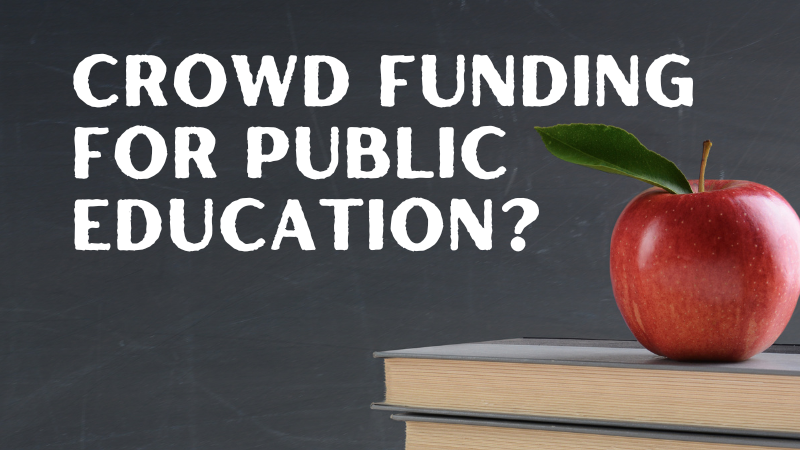
Previously published in the Winnipeg Free Press Dec 5, 2022
Students knocking on doors to fundraise for classroom books, school libraries, and general school supplies was already a strange practice. After all, these are basic educational materials essential to schooling that should be fully funded through the provincial education budget. In a dystopian vision of door-knocking, school divisions have started to use online apps with “helpful tips” about how to improve fundraising for public education.
Amid ongoing education funding shortfalls, Manitoba public schools have been forced to turn to alternative forms of funding, including fundraising, collecting student fees, recruiting international students who pay expensive tuition, and securing private-public partnerships. According to researchers Yoon, Young and Livingstone, non-governmental revenue in Manitoba school systems has risen from $12 million in 1998 to $27 million in 2017. This is a concerning trend. Public education is a public good and, therefore, a public responsibility. When the government abandons its responsibility to fund education, school divisions are forced to turn to private sources. This increased reliance on private funding exacerbates inequities and normalizes the privatization of a public good.
The public schools act states that the “Province of Manitoba and school divisions and districts share responsibility for the financing of the public schools.” Despite the expectation for robust and consistent public funding, divisions are forced to rely on fundraising to support basic activities and facilities. Fundraising manifests in school-based fundraising (such as selling books, food items, tickets for draws, etc.) and donations from local businesses and community members. Because fundraising requires parental time and money, as well as community support, schools located in more affluent areas have more resources to draw on. Conversely, schools in less affluent areas that are less successful at raising funds (because they have fewer resources to draw on) cannot make up for budget shortfalls and so go without services, resources, and supports. This disparity flies in the face of the purpose of public education and the obligation to: “serve the best educational interests of students”; “contribute to the development of students’ talents and abilities”; and “contribute to the development of a fair, compassionate, healthy and prosperous society,” as stated in the Public Schools Act. Public schools are meant to offer all students equal opportunity to fully participate. Access to quality education should not be anchored to cookie sales.
Another means to fund schools has been through student fees. Families pay a variety of fees, including registration fees, school supplies fees, lunch supervision fees, art fees, music fees, sports fees, field trip fees, and more. Research shows that, “costs to parents can run as high as a thousand dollars a year per child.” This is a prime example of how the government is downloading its responsibility to fund public schools onto families. As school fees creep up year after year, the public consent for privatization is manufactured. Parents feel obligated to pay fees as they don’t want their children denied opportunities, yet this compliance normalizes the idea that public school costs money which allows the government to continually divest.
Manitoba school divisions also recruit international students who pay more than $10 000 per year (plus application fees, medical insurance, and more) to attend Manitoba’s public schools. Schools in more sought out locations have an easier time attracting students. This creates significant inequities between divisions who can attract paying students and those who cannot. The current practices of recruiting international students is also unethical; when international students arrive, schools lack the resources to support the specific language, social-emotional, and learning needs of these students.
Finally, schools are increasingly forced to engage in public-private partnerships to cover education funding shortfalls. By partnering with private corporations to fund various educational projects, such as new playgrounds, technology upgrades, improved classroom facilities, or curriculum resources, schools become beholden to these private companies. These public-private partnerships benefit private businesses, and as divisions come to rely on private investment, the power shifts toward corporations who are afforded greater influence over public schooling. Decisions about public education should be made by the public, with the public interest in mind–not by corporations whose main objectives are revenue generation.
Alternative forms of education funding, including fundraising, student fees, international student tuition, and public-private partnerships, are a direct assault on public education. By forcing schools to rely on these alternative revenue streams, the provincial government is exacerbating inequities and dismantling one of society’s most valuable public goods. Ultimately, governments cannot abdicate their responsibility. Public education is a public good that should be fully and proudly publicly funded.
Shannon Moore is an Assistant Professor, Justin Fraser is a Master of Education student, and Melanie Janzen is an Associate Professor in the Faculty of Education at the University of Manitoba. They are members of People for Public Education and Research Affiliates with the Canadian Centre for Policy Alternatives – Manitoba. This op-ed is the second in a series adapted from speeches given by the authors at the Picnic for Public Education event on September 11, 2022.


